Kenneth L. Gentry Jr.'s Blog, page 26
May 26, 2023
SPIRITUAL RESURRECTION AT DEATH?
PMW 2023-042 by Kenneth L. Gentry, Jr.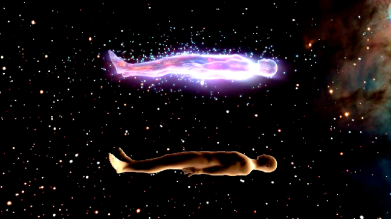
In the universal, historic Christian faith, we have long believed in an intermediate state. That is, the state of existence that we experience immediately upon death and prior to the distant physical resurrection at the end of history. In certain forms of Hyperpreterism, as has been recently so vigorously promoted, there is no intermediate state: you die, are given a spiritual “resurrection” body, and you live in heaven forever.
Another reason many Hyperpreterists deny an intermediate estate is because this system also lacks a consummation. In this unorthodox theology’s view, history continues forever. This is necessarily so since (they believe) all biblical prophecy has been fulfilled in the first century at the destruction of the temple in AD 70.
Consequently, what we are now experiencing — prevailing sin, rebellion against God, the decay of all physical systems, and physical death in history, all which occur in the present operational universe — will continue occurring in history forever and ever and ever and ever. (We are not speaking of the cessation of the eternal, conscious torment experienced under God’s righteous judgment, which is endured by unbelieving sinners while forever constrained in and confined to hell. Hell is a place we cannot access from within the objective universe and which, therefore, cannot impact history or threaten God’s people.)
For the Hyperpreterists, there is no “final” judgment; there is no renewal of the physical universe. Muddling-on is the ongoing reality for God’s physical creation. Not muddling “through,” mind you. For the muddling never ends, it never gets “through” history.
Have We Missed the Second Coming: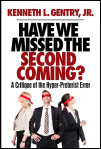
A Critique of the Hyper-preterist Error
by Ken Gentry
This book offers a brief introduction, summary, and critique of Hyper-preterism. Don’t let your church and Christian friends be blindfolded to this new error. To be forewarned is to be forearmed.
For more Christian educational materials: www.KennethGentry.com
In Hyperpreterism there is no intermediate state where we experience a delay in receiving the final fullness of our salvation (i.e., the resurrection of our body, Rom. 8:20–23) or where the unrighteous receive the final fullness of God’s wrath (Matt. 10:28).
Various unorthodox theologies (including some forms of the ever-changing Hyperpreterism movement) argue that Scripture teaches a new spiritual body for the deceased, which they receive at the moment of death. They will often point to various passages that seem to describe the deceased as not only existing alive (as does historic orhtodoxy), but also in bodies that have parts just as we do now and even recognizable based on their prior earthly sojourn.
For instance, when the deceased Samuel appears to Saul through the witch of Endor we see him wearing his royal robe (1 Sam. 28:14). When the deceased kings of the nations greet the dead king of Babel, they are sitting on thrones such as they had on earth (Isa. 14:9). When Jesus speaks of the dead rich man, he refers to his eyes and tongue (Luke 16:22–24) as well as the deceased Lazarus’ “finger” (v. 24).
How can this be if the dead are in an intermediate state as spirits awaiting their resurrection bodies (per historic Christianity)? It seems that they already have bodies as of the moment of their deaths. But looks are deceiving.
By way of response we must note firstly, Scripture does teach that when we die in history we enter heaven as disembodied spirits. Consider the following evidence.
Ecclesiastes 12:7: “Remember Him before the silver cord is broken and the golden bowl is crushed, the pitcher by the well is shattered and the wheel at the cistern is crushed; then the dust will return to the earth as it was, and the spirit will return to God who gave it.”
Luke 23:46: “And Jesus, crying out with a loud voice, said, ‘Father, into your hands i commit my spirit.’ Having said this, He breathed His last.”
Acts 7:59–60: “They went on stoning Stephen as he called on the Lord and said, ‘Lord Jesus, receive my spirit!’ Then falling on his knees, he cried out with a loud voice, ‘Lord, do not hold this sin against them!’ Having said this, he fell asleep.”
Hebrews 12:22–23: “You have come to Mount Zion and to the city of the living God, the heavenly Jerusalem, and to myriads of angels, to the general assembly and church of the firstborn who are enrolled in heaven, and to God, the Judge of all, and to the spirits of the righteous made perfect.”
 Why I Left Full-Preterism (by Samuel M. Frost)
Why I Left Full-Preterism (by Samuel M. Frost)
Former leader in Full Preterist movement, Samuel M. Frost, gives his testimony and theological reasoning as to why he left the heretical movement. Good warning to others tempted to leave orthodox Christianity.
See more study materials at: KennethGentry.com
Furthermore, we should note the following regarding the verses used by those arguing for an immediate corporeality after death.
The Bible speaks of God as having body parts, such as eyes (Psa. 32:8; Prov. 15:3), hands (Psa. 18:15; Isa. 62:3), a face (Num. 6:25; Psa. 80:19), and feet (Nah. 1:3–4; Hab. 3:3–6). These are anthropomorphisms which are not to be taken literally (unless you are a Mormon). We must understand in a similar fashion the verses describing the deceased in heaven. As physical creatures tied to the material realm, we do not know how spirits operate after death. As Reformed theologian Herman Bavinck notes: “It is simply a fact that we cannot picture a pure [disembodied] spirit — its existence, life, and activity. . . . The body . . . belongs integrally to the essence of our humanity, we cannot form any mental picture of the life and activity of a soul that is separated from the body” (Reformed Dogmatics 4:616). Therefore, attributing body parts to the souls of deceased is mentioned figuratively to assist us in having some comprehension of spiritual life in heaven.
THE TWO AGES AND OLIVET (advertisement)
I am currently researching a study of the Two-Age structure of redemptive history. My starting point is based on the disciples’ questions to Jesus in Matthew 24:3. Much confusion reigns among those unacquainted with the Two-Age analysis of history, which was promoted by Jesus (Matt. 12:32; Mark 10:29-30) and by Paul (Gal. 1:4; Eph. 1:21). The Two Ages are not the old covenant and the new covenant, but world history since the fall and the consummate order following the Second Coming and the Final Judgment.
If you would like to support me in my research, I invite you to consider giving a tax-deductible contribution to my research and writing ministry: GoodBirth Ministries. Your help is much appreciated!
May 23, 2023
CHRIST, YOU, AND PSALM 22
PMW 2023-041 by Kenneth L. Gentry, Jr. 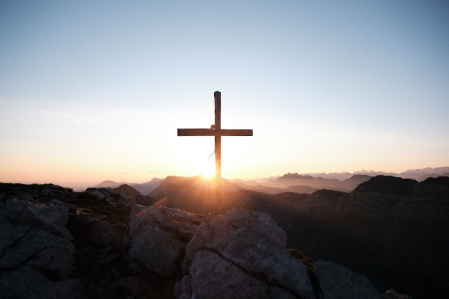
God’s plan of salvation brings together both glory and suffering for Christ. Through his suffering we will experience glory. And this experience of glory begins in history. Let us do a summary survey of Psalm 22 in this regard.
Psa. 22:1–31
According to its title, David wrote this psalm. It is divided into two basic parts: lamentation (vv. 1–21) and thanksgiving (vv. 22–31). It was written about some intense historical problem in David’s experience. Yet God’s Spirit lifts his poetic cry to Messianic significance and points to Jesus’s crucifixion as the ultimate Suffering One. Several details of Jesus’s passion appear within: forsakenness (v. 1), mockery (v. 8), shame (vv. 13, 17), piercing (v. 16), and dividing of his garments (v. 18). We see this in its use in the New Testament (Matt. 27:35, 39, 43, 46; John 19:23, 24, 28; Acts 2:30–31; Heb. 2:12).
Psa. 22:1–2
My God, my God, why have You forsaken me
This cry calls out of a sense of deep despair that is intensified by God’s apparent forsaking (v. 1). But even in despair it shows an abiding trust in God that leads to the psalmist’s continuing prayer (vv. 2–3).
Psa. 22:4–5
In You our fathers trusted
The psalmist’s deep despair clearly evident in God’s forsakenness (v. 1). Yet he recalls God’s past deliverances and approaches him on that basis. It is important that we know the Bible and the history of God’s people so that we may be encouraged to hope in his deliverance.

Covenantal Theonomy
(by Ken Gentry)
A defense of theonomic ethics against a leading Reformed critic. Engages many of the leading objections to theonomy.
See more study materials at: www.KennethGentry.com
Psa. 22:6–17
All who see me sneer at me
In addition to his physical suffering (vv. 13–17) and feeling of the absence of God (v. 1), the writer is also enduring the mockery of men (v. 7a) scoffing at his trust in God (vv. 7b–8). Yet he remembers that God brought him into the world, and therefore he still trusts in him (vv. 9–10), so that he calls upon him (v. 11).
Psa. 22:16
They pierced my hands and my feet
The imagery of his assailants as “dogs” (v. 16a–b) gives rise to the image of wild dogs (1 Kgs. 14:11; 16:4; 21:23; Jer. 15:3) piercing his hands and feet as he tries to defend himself and ward them off. We must note that the New Testament mentions the piercing of both Jesus’s hands and feet (Luke 24:39–40).
Psa. 22:17–18
They divide my garments among them
This is an image of a victorious army gathering the spoils of conquest (Josh. 7:21; Jdg. 8:25; 2 Chron. 20:25). This occurs after the vanquished person is defeated and stripped of his clothing so that his emaciation can be seen and stared at (v. 17). Providentially this comes to full expression in Jesus’s experience at the crucifixion (Matt. 27:35; Mark 15:24; Luke 23:34; John 19:23–24).
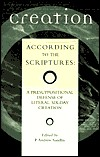 Creation according to the Scriptures
Creation according to the Scriptures
Ed. by P. Andrew Sandlin
This book is sub-titled: A Presuppositional Defense of Literal , Six-day Creation. It has chapters by R. J. Rushdoony, Andrew Sandlin, Kenneth Gentry, Cornelius Van Til, and others. It touches on historical, exegetical, theological, and philosophical implications of Six-day Creation.
See more study materials at: www.KennethGentry.com
Psa. 22:22–31
This second part of the psalm turns to thanksgiving despite the psalmist’s intense suffering. And as usual for David, he wants to declare God’s praise in the worship assembly (vv. 22, 25). The psalm’s title notes that he gave the psalm to the “choir director” for public worship.
Psa. 22:27–31
All the ends of the earth will remember and turn to the LORD
David himself is encouraged by God’s grace (v. 24) and he longs to declare his praise in the worship assembly (vv. 22, 25). Yet he also notes that the “ends of the earth” will turn to God in worship (vv. 27–30). This anticipates the fulfillment of the Abrahamic Covenant (Gen. 12:3; Psa. 2:7–9). Both testaments breathe the confidence of God’s victory over the world before the end comes.
THE TWO AGES AND OLIVET (advertisement)
I am currently researching a study of the Two-Age structure of redemptive history. My starting point is based on the disciples’ questions to Jesus in Matthew 24:3. Much confusion reigns among those unacquainted with the Two-Age analysis of history, which was promoted by Jesus (Matt. 12:32; Mark 10:29-30) and by Paul (Gal. 1:4; Eph. 1:21). The Two Ages are not the old covenant and the new covenant, but world history since the fall and the consummate order following the Second Coming and the Final Judgment.
If you would like to support me in my research, I invite you to consider giving a tax-deductible contribution to my research and writing ministry: GoodBirth Ministries. Your help is much appreciated!
May 19, 2023
PSALM 2 AND POSTMILLENNIALISM
PMW 2023-040 by Kenneth L. Gentry, Jr.
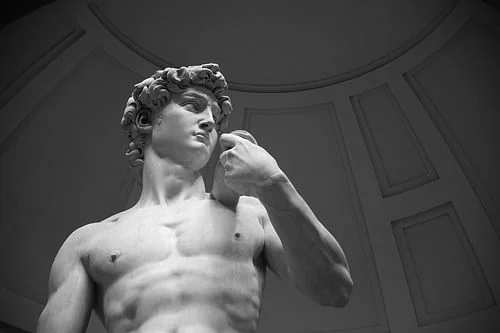
Like Isaiah 2, Psalm 2 provides powerful evidence for postmillennialism in the Old Testament. As I did with the preceding articles on several Isaiah passages, here I will present just a quick, running analysis of this glorious Psalm.
Psa. 2:1–12
This is a royal psalm, wherein David (Acts 4:25) recalls his enthronement. It is also a Messianic Psalm, which skillfully weaves together David’s human kingship with Jesus’s divine (Messianic) kingship. As such it is a counterpart to Psalm 110 (see Psa. 110:1–7 Note). It is frequently cited in the New Testament (see esp. Acts 4:25–27; cp. Matt. 3:17; 17:5; Acts 13:33; Rom. 1:4; Heb. 1:5; etc.). David the king and Jesus the Messiah are related both biologically and theologically (Matt. 1:1; 22:41–46; Rom. 1:4): David is a type of Christ. Though the psalm opens with turmoil (vv. 1–3) it promises the universal dominion of God’s Son (vv. 7–9), then ends with a gracious invitation for kings to submit to God’s rule (vv. 10a, 11, 12a) — or be destroyed (vv. 10b, 12b).
Psa. 2:1
Why are the nations in an uproar
Evidently David writes this psalm during some crisis in his kingdom (perhaps 2 Sam. 10?). Knowing that God’s covenant promises his kingdom’s permanent establishment (2 Sam. 7:8–16), David is astonished that the nations would bother to rebel against his rule. Thus, the very opening of the psalm sounds a note of confidence regarding the “vain” attempt to overthrow his rule (vv. 2–3). The word translated “devising” is the same word translated “meditate” in Psalm 1:2. While the righteous meditate on God’s word for directives for righteous living, the wicked meditate on vain actions doomed to catastrophic failure.
Psa. 2:2a
The kings of the earth take their stand
Though this undoubtedly reflects some current crisis under David’s rule (see v. 1 Note), the New Testament recognizes its deeper significance. When Peter and John were warned by the Jewish authorities not to speak about Jesus in Jerusalem, they responded by referencing this psalm to show that opposition to Christ is “futile.” They apply this psalm to Herod and Pontius Pilate’s roles in crucifying Christ and in persecuting his followers (Acts 4:25–28). The apostles (Peter and John, Acts 4:19) are confident as the march of the Christian faith throughout the world begins (Matt. 28:18; Acts 1:8; cf. John 3:17; 12:32).

Blessed Is He Who Reads: A Primer on the Book of Revelation By Larry E. Ball
A basic survey of Revelation from an orthodox, evangelical, and Reformed preterist perspective. Ball understands John to be focusing on the destruction of Jerusalem and the temple in AD 70. Insightful. Easy to read.
For more Christian studies see: www.KennethGentry.com
Psa. 2:2b
Against the LORD and … His Anointed
The nations’s attempt to overthrow David’s rule is “vain” (v. 1), i.e., empty or worthless. This is because they align themselves not only against the Lord’s Anointed, but the Lord God himself. The Hebrew word for “Anointed” is mashiach, the word from which we derive “Messiah.” The Greek translation of the Hebrew word is christos (“Christ”). The prophets spoke of a coming Davidic king (Isa. 9:2–7; Jer. 23:5–6; 33:14–16; Eze. 34:23–24; Hos. 3:5) who would rule the nations in righteousness (Isa. 2:2–4; 11:10; Mic. 4:1–5).
Psa. 2:4–5
He who sits in the heavens laughs
Despite the raging of the nations, the Lord scornfully mocks the opposition to his rule (cf. v. 2). The psalmist turns his attention from the earthly sphere (vv. 1–3) to the heavenly realm as he declares his confidence in God’s rule. Believers must always factor God into their daily lives and concerns (Matt. 10:28; John 14:1, 27; Rom. 8:28).
Psa. 2:6a
I have installed My King
In the Hebrew, the “I” is emphatic as God counters the bombast of the kings of the earth (vv. 1–3). As with Israel of old, we must recognize that the outcome of all issues is up to God alone (Psa. 75:6–7; Dan. 2:21; 4:17).
Psa. 2:6b
Upon Zion
“Zion” is the name of a hill in Jerusalem, the city of David (Neh. 3:15; Luke 2:4, 11). It was the location of the fortress David captured from the Jebusites (2 Sam. 5:6–7; 1 Chron. 11:4–9). The name “Zion” applies to this stronghold in Jerusalem (Isa. 40:9; Mic. 3:12). God chose it as his dwelling place (Psa. 132:13).
Psa. 2:7–9
I will surely tell of the decree of the LORD
These verses highlight the Davidic Covenant (2 Sam. 7:8–16), which promises that his descendant’s rule will be forever. The rule is not only everlasting, but here is even declared to extend to all “the nations” and to the “ends of the earth” (v. 8; cp. Psa. 67:7). This ultimately speaks of the kingdom of David’s greater son, Jesus Christ (Luke 1:32–33; Acts 2:25–36). This will be fulfilled by means of Christ’s Great Commission (Matt. 28:18–20; cp. Acts 1:8). Christ’s kingdom is divinely-ordained to conquer the world in righteousness (Isa. 2:2–4; 9:6–7; 11:1–16; cp. Psa. 22:27; 72:8–11; John 3:17; 12:32; see Gen. 12:3 Note). This hope was already embedded in the patriarchal promises (Gen. 22:17–18; 26:4; 28:14) and is confirmed by Jesus (John 3:17; 12:31–32). Believers must always trust in Christ’s victory in time and on earth.
Psa. 2:7
You are My Son
This statement by the Lord in heaven (vv. 4, 6) declares the king to be his divine Son. David is such typologically (2 Sam. 7:12–16); but Jesus is God’s Son personally (Heb. 1:5; Matt. 1:1). According to Paul, this adoption comes to full expression at Jesus’s resurrection (Acts 13:33; Rom. 1:4). However, earlier declarations at his baptism (Matt. 3:17) and transfiguration (Matt. 17:5) marked him out as God’s Son.

Charismatic Gift of Prophecy (by Kenneth Gentry)
A rebuttal to charismatic arguments for the gift of prophecy continuing in the church today. Demonstrates that all revelatory gifts have ceased as of the conclusion of the Apostolic era.
See more study materials at: www.KennethGentry.com
Psa. 2:9
You shall break them with a rod of iron
The Messiah (see vv. 1–12 Note) will effectively rule over the nations (v. 8), even if he has to employ destructive force. This verse appears three times in Revelation, once concerning Christians as co-rulers with Christ (Rev. 2:26–27) and twice regarding Christ himself (Rev. 12:5; 19:15). In the LXX the Hebrew word for “break” is translated “shepherd” or “rule.” Christians have a calling to engage Christ’s rule among the nations (2 Cor. 10:3–5; Rev. 20:4–6).
Psa. 2:10–12
Now therefore, O kings
The psalmist now calls on the world’s kings and judges (v. 10) to “worship the Lord” (v. 11). Serving him with “fear” would represent wisdom on their part (Psa. 111:10; Prov. 9:10; 15:33). This is a gracious call, even though it holds out a terrifying warning of his potential wrath.

THE TWO AGES AND OLIVET (advertisement)
I am currently researching a study of the Two-Age structure of redemptive history. My starting point is based on the disciples’ questions to Jesus in Matthew 24:3. Much confusion reigns among those unacquainted with the Two-Age analysis of history, which was promoted by Jesus (Matt. 12:32; Mark 10:29-30) and by Paul (Gal. 1:4; Eph. 1:21). The Two Ages are not the old covenant and the new covenant, but world history since the fall and the consummate order following the Second Coming and the Final Judgment.
If you would like to support me in my research, I invite you to consider giving a tax-deductible contribution to my research and writing ministry: GoodBirth Ministries. Your help is much appreciated!
May 16, 2023
MISUNDERSTANDING “LUCIFER”
PMW 2023-039 by Kenneth L. Gentry, Jr.

Isaiah’s prophecy regarding “Lucifer” (Isa. 14:12) is a fairly well-known passage in the Old Testament. Unfortunately, among most Christians and in much of popular culture it is widely misunderstood. In this article I will give a brief survey of the relevant verses in Isaiah 14, which should re-direct your thinking if you understand Lucifer to be Satan.
Isa. 14:1–4: When the LORD will have compassion on Jacob.
These four prose verses show that the preceding poetic movement has ended (see 13:1–14:23 Note). The next movement begins in v. 4b. Both movements are directed against Babylon (vv. 1, 17, 19; 14:4, 22). Though Israel will be banished from her land by Babylon (see Isa. 6:12 Note), God will bring her back (vv. 1–3). Her future return from exile echoes the original exodus from Egypt and serves as a new hope-filled beginning for her. And this even looks further into the future to her ultimate “exodus” from the bondage of sin under Jesus as he calls out a new “Israel of God,” which is a being formed as a “new creation” (Gal. 6:15–16; cp. 2 Cor. 5:17). Jesus speaks of this with Moses at the transfiguration (Luke 9:31; “departure” is the translation of the Greek exodos).
Isa. 14:1: strangers will join them and attach themselves to the house of Jacob.
This is not simply a return of Jews to their original land (though it does speak of the return from Babylonian exile; see vv. 1–4 Note). More distantly and fully, however, the “strangers” here are Gentiles who will become a part of the future “Israel of God” in which circumcision does not matter (Gal. 6:15). this will begin fulfilling the promise of salvation and the inclusion of Gentiles among God’s people (see 11:12 Note; cp. Matt. 28:18–20; John 10:16; Acts 11:18; 13:46–48; Eph. 2:11–12).
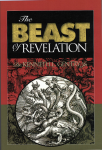
The Beast of Revelation
by Ken Gentry
A popularly compiled presentation that serves as an antidote to dispensational sensationalism and newspaper exegesis. Convincing biblical and historical evidence showing that the Beast was the Roman Emperor Nero Caesar, the first civil persecutor of the Church. The second half of the book shows Revelation’s date of writing, proving its composition as prior to the Fall of Jerusalem in A.D. 70. A thought-provoking treatment of a fascinating and confusing topic.
For more study materials, go to: KennethGentry.com
Isa. 14:4: take up this taunt against the king of Babylon.
The word “taunt” is the Hebrew mashal, which is often translated “proverb.” The word means “like, similar” and thus employs figurative language. Here it is a proverb used in a mocking sense. In a similar passage it is translated “taunt-song,” i.e., a satirical poem (Hab. 2:6). At that future time Israel will sing (Heb., nasa, “raise up,” as in raising one’s voice in a song) this taunt (14:4b–23) against “the king of Babylon” (v. 4; cf. vv. 8–11, 16). This is poetic imagery and does not mean Israel will literally learn, practice, and sing these words. The taunt opens with the word “how” (Heb., ‘ek), which is a common word in funeral poems (e.g., 2 Sam. 1:19, 25, 27) and laments (Psa. 137:4; Jer. 9:19; 48:14, 39; Lam 1:1; 4:1). Here it is used ironically as Israel rejoices through mock-lamenting over the death of a tyrant, “the king of Babylon.”
Isa. 14:6–11: The whole earth is at rest and is quiet.
With the breaking of the power (vv. 5–6) of Babylon’s king (vv. 1, 19), the nations previously oppressed (vv. 4–6) by him will now live in “rest and quiet,” i.e., peace (vv. 7–8). In contrast to the nations’s calm “rest,” as the Babylonian king descends into death, “Sheol from beneath is excited.” It is agitated regarding the king’s fall (v. 9) to such a “low” (v. 8) position in the grave (i.e., “Sheol,” see Gen. 37:35b Note). “All the kings” who have died (v. 9) now taunt him for his weakness after his having been so powerful (vv. 9–10). In the grave he is loathsome, being covered with maggots and worms (v. 11).
Isa. 14:12: How you have fallen from heaven, / O star of the morning.
In antiquity the collapse of a great political leader or nation is often called a fall from “heaven.” We see this in Cicero, ad Atticum 2:21; Philippicum 2:41; Horace, Epodes 17:41; etc. For the KJV translation “Lucifer” instead of “star of the morning.”
The KJV’s translation has the word “Lucifer” here. “Lucifer” (“light-bearer”) is the Latin Vulgate translation of the Hebrew helel, which means “shining one.” This translation has helped promote a radical misunderstanding of the text in the modern world.
Despite popular opinion today (and by many ancient and medieval writers), Lucifer is not Satan. Notice: (1) The taunt is clearly directed against “the king of Babylon” (v. 4). (2) It speaks of the fall of “the man who made the earth tremble” (v. 16), who has “ruined your country” (v. 20). (3) It associates him with other earthly kings who have died (vv. 18–19). (4) It speaks of his burial problem (v. 20). (5) Furthermore, this taunt-oracle opens a series of prophecies against various earthly kings: Babylon (14:4), Assyria (14:24), Philistia (14:29), Moab (15:1), Damascus (17:1), Egypt (19:1), Jerusalem (22:1, 9–10), and Tyre (23:1). It would be out of keeping with the series to import Satan into this taunt.
Faith of Our Fathers (DVDs by Ken Gentry) Explains the point of creeds for those not familiar with their rationale. Also defends their biblical warrant and practical usefulness for defending historic, Christian orthodoxy in our heterodox world. See more study materials at: www.KennethGentry.com
Unfortunately, much confusion arises from not properly dealing with the poetic genre in which this oracle appears. Poetry allows extravagant description such as applied here to “Lucifer” (i.e., the king of Babylon). In the very context we read of trees rejoicing and speaking (14:8a) because war ceases with his death (v. 7) so that trees will no longer be cut down to make siege weapons (v. 8b).
“Lucifer” is better translated as “shining one,” referring to Venus, the morning star (as per the NASB and NRSV; similarly, ASV, ESV, NIV, RSV). This fits well with the astrological and polytheistic commitments of the Babylonian king who sought to raise himself above all others (see vv. 13–14 Note).
Isa. 14:13–14: you said in your heart, / I will ascend to heaven.
In these two verses we hear the Babylonian king’s proud boasting: we read “I” five times. And we see multiple references to height: “ascend,” “heaven,” “above the stars,” “sit on the mount,” “above the heights of the clouds,” and his desire to be “like the Most High.” He was determined to sit regally in the “mount of assembly” of the gods in “the north [Heb., saphon].” In Ugaritic poems, Saphon is the place where Baal is enthroned.
Isa. 14:15: you will be thrust down to Sheol, / To the recesses of the pit.
For all the king’s wordy boasting (see vv. 13–14 Note), God quickly disposes of him. In vv. 13–14 his lengthy boast employed eighteen words in Hebrew, whereas God only uses five Hebrew words to discard him (v. 15). All of his pompous boasts of ascending the heights are replaced with the lowest places where he will actually end up: He will be “thrust down,” “to Sheol,” even to the “recesses of the pit” (v. 15). When man attempts to be equal with God, his fall into ruin is sure (cf. Gen. 3:5, 16–24; Eze. 28:2, 6–10).
Isa. 14:18–20: you have been cast out of your tomb.
In antiquity burial monuments for kings were important, as we may discern from the most remarkable ones, the Egyptian pyramids. Hence, “all the kings … each in his own tomb” like in glory. But the Babylonian king will not be accorded a decent burial, becoming instead like a “trampled corpse” (vv. 18–19).

THE TWO AGES AND OLIVET (advertisement)
I am currently researching a study of the Two-Age structure of redemptive history. My starting point is based on the disciples’ questions to Jesus in Matthew 24:3. Much confusion reigns among those unacquainted with the Two-Age analysis of history, which was promoted by Jesus (Matt. 12:32; Mark 10:29-30) and by Paul (Gal. 1:4; Eph. 1:21). The Two Ages are not the old covenant and the new covenant, but world history since the fall and the consummate order following the Second Coming and the Final Judgment.
If you would like to support me in my research, I invite you to consider giving a tax-deductible contribution to my research and writing ministry: GoodBirth Ministries. Your help is much appreciated!
May 12, 2023
THOUGHTS ON ISAIAH 11
PMW 2023-038 by Kenneth L. Gentry, Jr.
 In my last posting I gave a brief survey of Isaiah’s glorious postmillennial hope as found in Isaiah 2. In this one I will quickly summarize this hope as it is found in Isaiah 11, another great chapter embodying the postmillennial hope.
In my last posting I gave a brief survey of Isaiah’s glorious postmillennial hope as found in Isaiah 2. In this one I will quickly summarize this hope as it is found in Isaiah 11, another great chapter embodying the postmillennial hope.
Isa. 11:1–2: a shoot will spring from the stem of Jesse.
Along with Assyria, Israel has been chopped down to a stump (10:18–19, 33–34). Yet the Messiah, the true Davidic king, will arise from the lineage of Jesse (vv. 1, 10; David’s father, 1 Sam. 16:10–31). Christ is the greater David who was typified in David (see 9:7b Note). He will be endowed with “the Spirit of the LORD” (v. 2), thereby exercising wisdom, understanding, counsel, strength, knowledge, and the fear of the LORD (v. 2).
Isa. 11:3–6: with righteousness He will judge the poor.
Where Israel’s rulers failed and earned God’s judgment (see 5:24 Note; 10:1–4 Note), the Messiah will exercise righteous rule (cf. v. 9).
Isa. 11:6–8: the wolf will dwell with the lamb.
This is poetry; it is not speaking literally of wolves, lambs, leopards, lions, and bears. These carnivores acting peacefully with herbivores picture the glory of Christ’s kingdom when it comes to full expression in history (see v. 11 Note). In Christ enmity is done away with and replaced by reconciliation (cf. Eph. 2:14–18).
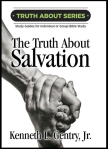 The Truth about Salvation By Ken Gentry
The Truth about Salvation By Ken Gentry
A study guide for personal or small group Bible study. Deals with the Christian doctrine of salvation from a Reformed theological perspective. It opens with a study of God as loving Creator, the shows how the first man fell into sin. Shows God’s righteousness requires that sin be dealt with. Presents Jesus as both God and man so that he can be man’s Savior. Includes review questions and questions for further study.Twelve chapters are ideal for one quarter of Sunday School.
See more study materials at: www.KennethGentry.com
Isa. 11:9–10: the earth will be full of the knowledge of the LORD.
Worldwide peace will eventually prevail on earth as the gospel gradually wins more converts (see 2:3–4 Note; 9:7a Note). This is what Christians pray for when we pray “Your kingdom come, Your will be done on earth” (Matt. 6:10) and what we aim for in promoting the great commission (Matt. 28:18–20). But this prophecy will come to fullest, perfect expression in eternity, when God establishes the consummate new heavens and new earth (2 Pet. 3:13) after the final judgment (2 Pet. 3:10–12).
Isa. 11:11–16: the Lord / Will again recover … / The remnant of His people.
Once again the hope of the remnant is presented: despite his vigorous judgments, God will not destroy Israel. She will live on in a remnant that becomes the new covenant church (Eph. 2:11–22), which is “the Israel of God” (Gal. 6:15). Thus, the new covenant church is not a replacement for Israel, but the fulfillment of Israel for in her “all Israel will be saved” (Rom. 11:26).
Isa. 11:12: a standard for the nations.
A “standard” (or “banner”) is some sort of sign or signal that is lifted up to rally troops to assemble (cf. v. 10; 13:2; 49:22–24). Once again we see the universality of God’s plan: he will ultimately include the Gentiles (“the nations,” cf. Isa. 19:20–25; Matt. 28:18–20; see Notes at Gen. 12:3; Isa. 2:2–4; 9:7a; 11:12; 18:7).
Click on the following images for more information on these studies:



THE TWO AGES AND OLIVET (advertisement)
I am currently researching a study of the Two-Age structure of redemptive history. My starting point is based on the disciples’ questions to Jesus in Matthew 24:3. Much confusion reigns among those unacquainted with the Two-Age analysis of history, which was promoted by Jesus (Matt. 12:32; Mark 10:29-30) and by Paul (Gal. 1:4; Eph. 1:21). The Two Ages are not the old covenant and the new covenant, but world history since the fall and the consummate order following the Second Coming and the Final Judgment.
If you would like to support me in my research, I invite you to consider giving a tax-deductible contribution to my research and writing ministry: GoodBirth Ministries. Your help is much appreciated!
May 9, 2023
QUICK SUMMARY OF ISAIAH 2
PMW 2023-037 by Kenneth L. Gentry, Jr.
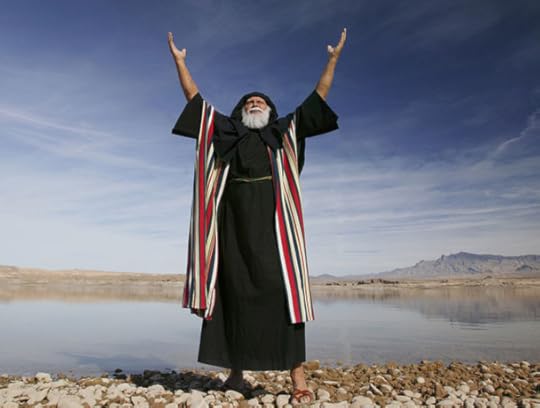
Isaiah is an important book in Scripture and an invaluable witness to the postmillennial hope. We may see the importance of Isaiah in the following.
Isaiah has been widely used. The book of Isaiah has long been important to God’s people. We see this in several ways. Among the Jews at Qumran, the second most cited book in the Dead Sea Scrolls is Isaiah, exceeded only by Deuteronomy. Not only do we find among these Scrolls a complete, well–preserved Isaiah scroll, but twenty partially-preserved copies. The New Testament alludes to Isaiah 411 times, directly quoting it over fifty times (e.g., Matt. 13:14–15; Luke 8:10; John 12:40; Acts 28:26–27; Rom. 9:29; Heb. 2:13; 1 Pet. 2:9).
The next three observations explain why Isaiah was so popular to New Testament writers.
Isaiah presents us with an exalted view of God. It especially emphasizes his sovereignty (6:1ff; 24:1–3; 37:15–20; 43:8–11) and his holiness (1:4; 5:16; 30:9–16; 37:23; 43:8–11). And in light of these glorious doctrines, it especially condemns human pride (2:11–18; 14:12–15; 37:23–25; 66:1–3).
Isaiah is strongly eschatological. With its strong emphasize on God’s sovereignty (see above), it repeatedly speaks of the future conversion of the Gentile nations (Isa. 2:2–4; 11:6–10; 19:16–25; 42:1–12; 49:5–6; 60:1–3).
Isaiah is strongly Messianic. Only Psalms has more references to Christ than does Isaiah. Of its many Messianic passages, we may include: 7:10–15; 9:1–7; 8:23–9:6; 11:1–16; 14:28–32; 24:21–23; 32:1–8; 33:17–24; 42:1–4; 49:1–6; 50:4–9; 52:13–53:12; 59:21; 61:1–3, 10–62:7; 63:1–6.

Three Views on the Millennium and Beyond (ed. by Darrell Bock)
Presents three views on the millennium: progressive dispensationalist, amillennialist, and reconstructionist postmillennialist viewpoints. Includes separate responses to each view. Ken Gentry provides the postmillennial contribution.
See more study materials at: www.KennethGentry.com
And it is especially in Isaiah 2 that we are presented with a robust postmillennial hope. Let us survey a few verses here for our encouragement.
Isa. 2:2–4: This short introductory prophecy is confident (“it will come about,” v. 2a) and powerful (“will be established as the chief of the mountains,” v. 2c–d). It declares the glorious future of God’s people (see 1:27 Note). And it will come despite their present failure (cf. 1:2–31; 2:5–11). As such, it introduces the larger section of prophetic material to follow (2:5–4:6). This brief prophecy is almost identical to Micah’s (Mic. 4:1–3; cf. Joel 3:10). The prophecy was probably original to Isaiah since it is introduced as something which he himself “saw” (Heb., Haza, v. 1), whereas no such statement (“saw”) or personal claim (“the word which Micah saw”) appears in Micah, who apparently borrowed it from Isaiah.
Isa. 2:2b: it will come about that / In the last days. The phrase “the last days” is an important feature of biblical eschatology. The “last days” are the times initiated by Christ at his first coming “in these last days” (Heb. 1:1–2; cp. 1 Cor. 10:11; Gal. 4:4), which began at Pentecost (Acts 2:16, 17, 24). Significantly, this prophecy will transpire “in,” i.e., during or in the course of “the last days,” not after they have been completed. Thus, it is to occur in history during the last days that will end at “the last day” resurrection (John 6:39, 40, 44, 54; 11:24). They are the “last” days of earthly history, not the forerunner to a thousand more years of history, as per the premillennial scheme.
Isa. 2:2c–e: The mountain of the house of the LORD. The “house of the LORD” refers to the new covenant church (1 Cor. 3:16; 6:19; 2 Cor. 6:16; Eph. 2:19–22; 1 Pet. 2:5), which was “established” (Heb., kun implies of permanent duration) on earth “in the last days” (see 2:2b Note). It is a “mountain” in that it is a city set on a hill (Matt. 5:14; Heb. 12:22). It is to be “the chief of the mountains” (v. 2d) in that it will eventually be the world’s leading influence. Contrary to dispensationalism, this is not to be taken literalistically, as if Jerusalem will physically be elevated higher than Mount Everest (with all the health difficulties that would bring).
Isa. 2:2f: all the nations will stream to it. The final period of redemptive history (see 2:2b Note) that stretches from the first to the second comings of Christ will eventually see the church “established as the chief of the mountains” (v. 2d). Thus, “all the nations will stream to it,” making it a history-changing, international influence, as expected in both the Old Testament (Gen. 12:1–3; 22:17; Psa. 2:6–8; 22:27; 72:5–8; 87:4; 110:1–2; Isa. 9:6–7; Jer. 3:16–17) and the New Testament (John 3:17; Rom. 11:25–27; 1 Cor. 15:20–28; Phil. 2:9–10). This is what we pray for in the Lord’s Prayer (Matt. 6:10) and what Jesus teaches us to expect (Matt. 28:18–20; Luke 24:46–47; John 12:32). See 9:7a Note; 11:6–8 Note.
Isa. 2:3–4: That He may teach us concerning His ways. The victory of the church in history will not come about catastrophically as Jesus returns in glory waging war. Rather, it comes about gradually as victory is secured through the powerful suasion of God’s law-word (v. 3b–d) that “goes forth from Zion” (the city of God, Heb. 12:22–28; cp. Matt. 28:18–20; Acts 1:8). It will gradually exercise its influence over “the nations” ( v. 4a) and become the basis of justice among “many peoples” (v. 4b), bringing about an era of worldwide peace (v. 4c–3; see: Psa. 72:8–17; Isa. 9:6–7; 11:9; 19:16–24; Jer. 3:16–17; Dan. 2:44; Mic. 4:1–4).
Isa. 2:6–10
In this portion of the his prophecy, Isaiah draws six contrasts between the world’s glorious future (2:2–4) and Israel’s sinful present: (1) The world will be drawn to righteous Zion (v. 2f), but Zion is currently drawn to the sinful world (v. 6b–d). (2) Many people will gladly go up to the mountain of the Lord (v. 3a–b), whereas Israel will go into the rocks to hide from the terror of the Lord (v. 10). (3) The world will seek to know God (v. 3b–d), whereas God’s people are making their own gods (v. 8). (4) The world will seek spiritual instruction (v. 3d–e), whereas Israel trusts in material wealth (v. 7a–b). (5) The world will be received by God (v. 4a–b), while God’s people are currently abandoned by God (vv. 6a, 9). (6) When the world comes to Zion they will enjoy peace (v. 4c–e), but Zion is now full of the implements of war (v. 7c–d).
Isa. 2:11
“That day” (Isa. 24:21), “the day” (Eze. 30:3), “the day of the Lord” (Isa. 13:9), “the great day of the Lord” (Zeph. 1:14), “a day of reckoning” (Isa. 2:12), “a day of vengeance” (Jer. 46:10), “the last day” (John 12:48), and related phrases point ultimately to the final day of the Lord, i.e., the final judgment. All historical divine judgments are small, local precursors April 19, 2022of the final great day of global judgment. The Old Testament has many singular “day of the Lord” announcements in different historical contexts. Sometimes they are “near” in history (Isa. 13:6, 9; Eze. 30:3; Joel 2:1; 3:14; Zeph. 1:7, 14). Yet they are unified by the fact that they are all distant pictures of the final day of the Lord. In the OT we have several “Day of the Lord” events: against Babylon (Isa. 13:9–10), Jerusalem (Joel 2:1), and others. Each of these is a pointer to the final cay of the Lord (2 Pet. 3:10–12), though each OT version is spoken of as “the” (singular) day of the Lord. This is much like our spiritual resurrection in salvation (John 5:24-25; 1 John 3:14) pointing to our final resurrection at the end of history (Acts 17:30–31). Or like the Christian’s being a “new creation” (2 Cor. 5:17; Gal. 6:15), which is a picture of the consummate new creation (2 Pet. 3:10).

Why I Left Full-Preterism (by Samuel M. Frost)
Former leader in Full Preterist movement, Samuel M. Frost, gives his testimony and theological reasoning as to why he left the heretical movement. Good warning to others tempted to leave orthodox Christianity.
See more study materials at: KennethGentry.com
THE TWO AGES AND OLIVET (advertisement)
I am currently researching a study of the Two-Age structure of redemptive history. My starting point is based on the disciples’ questions to Jesus in Matthew 24:3. Much confusion reigns among those unacquainted with the Two-Age analysis of history, which was promoted by Jesus (Matt. 12:32; Mark 10:29-30) and by Paul (Gal. 1:4; Eph. 1:21). The Two Ages are not the old covenant and the new covenant, but world history since the fall and the consummate order following the Second Coming and the Final Judgment.
If you would like to support me in my research, I invite you to consider giving a tax-deductible contribution to my research and writing ministry: GoodBirth Ministries. Your help is much appreciated!
May 5, 2023
QUICK NOTES ON THE RESURRECTION BODY
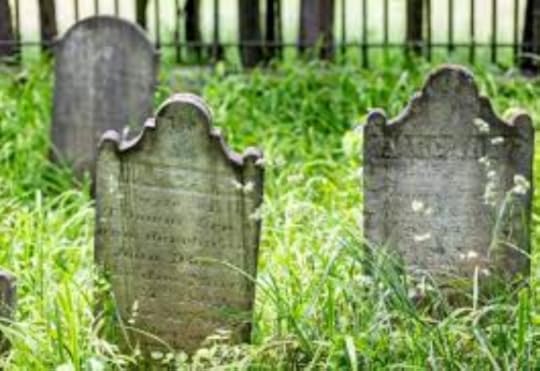
PMW 2023-036 by Kenneth L. Gentry, Jr.
Introduction
The physical resurrection of the dead is under attack in modern Christianity. Again. However, this time it is not just the liberals. Rather, some evangelical Christians themselves are denying the physical nature of the resurrection body. They often begin their denial by citing 1 Corinthians 15:44, which speaks of the resurrection body thus: “it is sown a natural body, it is raised a spiritual [pneumatikos] body. If there is a natural [pseuchikos] body, there is also a spiritual body [pneumatikos].” By misunderstanding this passage, the remainder of the Bible, and the power of God, opponents of the future, physical resurrection are, like Hymenaeus and Alexander: their faith is suffering shipwreck (1 Tim. 1:19–20; 2 Tim. 2:16–18).
This denial of the physical resurrection based on this famous passage is remarkable in that 1 Corinthians 15:44 has been in the NT for 2000 years. And during that time the universal, historic, orthodox Christian faith has held to a future physical resurrection. It even creedalized this great truth, which is “of first importance” regarding the gospel (1 Cor. 15:1–3). For instance, toward the end of the Apostles’ Creed we declare with the universal, historic, corporate Christian church that we believe “in the resurrection of the body and the life everlasting.” In the original language versions of the Creed, the resurrection of the “body” is more exactly declared to be the resurrection of the “flesh.” For in Latin the word carnis was used and in Greek sarx.
But there is abundant evidence in Scripture that the resurrection will be future, physical, and corporate. That is, it is not occurring now (for it is future). Nor is it a spiritual transaction (for it is physical). Nor does it transpire at the moment of each believer’s death, as they occur one-by-one (for it is corporate).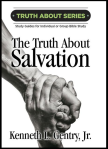
The Truth about Salvation By Ken Gentry
A study guide for personal or small group Bible study. Deals with the Christian doctrine of salvation from a Reformed theological perspective. It opens with a study of God as loving Creator, the shows how the first man fell into sin. Shows God’s righteousness requires that sin be dealt with. Presents Jesus as both God and man so that he can be man’s Savior. Includes review questions and questions for further study.Twelve chapters are ideal for one quarter of Sunday School.
See more study materials at: www.KennethGentry.com
Below I will present a succinct listing of some of the evidence for a future physical resurrection of the body Though my evidence is designed mostly to demonstrate the physical, corporeal nature of the resurrection, by doing such it will undercut any notion that it is happening today.
God’s Design for Man and Resurrection
By divine design, man is two-natured being composed of a unified body and soul (Gen. 2:7). In this he differs from angels who are spirits (Heb. 1:14). And the creation account declares that the physical creation of the world and of man was “very good” (Gen. 1:31), which shows that God would surely not discard it.
Old Testament Pointers and Resurrection
Resurrection is not just a New Testament issue. Many resurrections occur in the Bible — in both the Old (1 Kgs. 17:17–22; 2 Kgs. 4:18–37; 13:20) and the New Testaments (Mark 5:41; Luke 7:14; John 11:38–44; Matt. 27:52–53; Acts 9:36–42; 20:7–12). Each of these is clearly a physical resurrection that demonstrates God’s power (cp. Matt. 22:29; 1 Cor. 6:14). And serves as a pointer beyond themselves to the consummate eschatological resurrection For instance, when Jesus spoke of the deceased Lazarus rising again (John 11:23), his sister Martha immediately thought Jesus referred to the eschatological resurrection at the end (v. 24; which was the dominate view in first-century Judaism; see below). Then in response Jesus declares that he is the resurrection (anastasis, v. 25). In fact, several Old Testament passages present an eschatological resurrection, as we see in Job 19:25–27 and Isaiah 26:19.
God Gave Wine (by Ken Gentry)
A biblical defense of moderate alcohol consumption. Considers all key biblical passages and engages the leading objections.
See more study materials at: www.KennethGentry.com
First-century Judaism and Resurrection
The Pharisees believed in a physical resurrection (Acts 23:8), and Paul sided with them on this issue over against the Sadducees (Acts 23:6). In fact, “in classical Judaism, resurrection of the dead was a central belief, essential to defining oneself as a Jew” (Jon D. Levenson, Resurrection and the Restoration of Israel: The Ultimate Victory of the God of Life [Yale University Press, 2006]).
The Greek Word for “Resurrection”
The Greek word for “resurrection” is anastasis or anistemi, which means “stand up.” This refers to the body which has fallen down in death and will once again stand up in life — by resurrection. This will be just as Jesus rose again from the dead (John 20:9).
The Place of Resurrection
Thus, in John 5:28 the resurrection must involve the physical body for it occurs after death (not at the moment of death): at the tomb (John 5:25), that is, wherever the dead is resting. This passage also speaks of the resurrection as raising men from the tombs in a future, corporate action that involves both the righteous and unrighteous (John 5:28–29; cp. Acts 24:15; Rev. 20:13–15). It is not an ongoing action occurring at the moment when each individual dies.
The Necessity of Resurrection
Man in his full being exists as a body-soul complex. Thus, the unrighteous are necessarily judged in both body and soul in hell: “Do not fear those who kill the body but are unable to kill the soul; but rather fear Him who is able to destroy both soul and body in hell (Matt. 10:28). And for our part believers eagerly await “the redemption of our body” (Rom. 8:23).
Christ’s Physical Resurrection
Christ’s resurrection was physical (Luke 24:39; John 20:20, 27), leaving behind an empty tomb (John 20:1–2, 6–7). When Jesus was resurrected, it was his flesh (body) that was raised and which did not suffer decay (Acts 2:31–33). And his resurrection is deemed the “first fruits” of ours (1 Cor. 15:20, 23). The concept of “first fruits” is derived from the ancient practice of harvesting. The first fruits of a crop are of the same nature as the final, full harvest of the crop — except that they are first. The first fruit of corn does not produce wheat or barley. What is sown is that which is reaped (cf. Gal. 6:7). Consequently, Paul teaches that God “not only raised the Lord, but will also raise us up through His power” (1 Cor. 6:14), for “He who raised Christ Jesus from the dead will also give life to your mortal bodies through His Spirit who dwells in you” (Rom. 8:11).
The Jerusalem Saints’ Resurrection
When Jesus was resurrected, many bodies of the saints were raised from out of the tombs and were seen by many (Matt. 27:52–53). These were probably recently deceased saints, but the fact remains that these bodies were resurrected in celebration of Christ’s resurrection. And they point to our ultimate resurrection (see reference to “first fruits” above in this article). Theirs was not a part of the eschatological resurrection, so they would not have had transformed, imperishable bodies and would have died again later.
The Denial of Physical Resurrection
According to Christ, those who doubt a resurrection do not believe in the “power of God’ nor do they understand the Scriptures (Luke 22:29–32). They are like the pagan Athenians who mocked the resurrection idea (Acts 17:32), as well as the Corinthian heretics who doubted the resurrection (1 Cor. 15:8–19). And those who believe the resurrection is past are like Hymanaeus who jeopardize the faith of some (2 Tim. 2:16–18),
The “Spiritual” Body Resurrection
The “spiritual [pneumatikos] body” in 1 Corinthians (1 Cor. 15:44) is not a body made of spirit any more than a Coke bottle is a bottle made of Coke. Rather, it is a Spirit-filled, Spirit-dominated body. Similarly, the pneumatikos man (1 Cor. 2:14–15) is not an ethereal, physically intangible person, but one controlled by the Spirit. Because of the Spirit’s work and power in the resurrection, our bodies will possess new qualities making them imperishable, glorious, and powerful (1 Cor. 15:42–44). Thus, they are fitted for eternity where no more decay and death occur.
Conclusion
This quick survey of arguments sustains the view of historic Christianity regarding the future, corporate, physical resurrection. This is significant in that the physical resurrection lies at the very core of Christianity and its redemptive promise (1 Cor. 15:1–3). The universal Christian church has surely not been fundamentally wrong on one of its fundamental truths!

THE TWO AGES AND OLIVET (advertisement)
I am currently researching a study of the Two-Age structure of redemptive history. My starting point is based on the disciples’ questions to Jesus in Matthew 24:3. Much confusion reigns among those unacquainted with the Two-Age analysis of history, which was promoted by Jesus (Matt. 12:32; Mark 10:29-30) and by Paul (Gal. 1:4; Eph. 1:21). The Two Ages are not the old covenant and the new covenant, but world history since the fall and the consummate order following the Second Coming and the Final Judgment.
If you would like to support me in my research, I invite you to consider giving a tax-deductible contribution to my research and writing ministry: GoodBirth Ministries. Your help is much appreciated!
May 2, 2023
THE APOSTLES’ CREED & RESURRECTION
PMW 2023-035 by Kenneth L. Gentry, Jr.
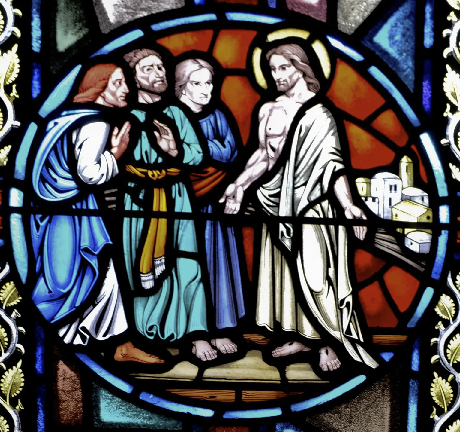
Toward the end of the Apostles’ Creed we declare with the universal, historic, corporate Christian church that we believe “in the resurrection of the body and the life everlasting.” According to Philip Schaff (The Creeds of Christendom, 1:22), in the original language versions of the Creed, the resurrection of the “body” is more exactly declared to be the resurrection of the “flesh.” For in Latin the word carnis was used and in Greek sarkos.
We know that the resurrection is a physical resurrection of the dead body for: (1) all forerunner resurrections (though temporal only) were physical resurrections of the flesh (e.g., John 11:43–44). (2) Old Testament prophecies speak of the resurrection of the flesh (Job 19:25–27; Isa. 26:19–20). (3) Jesus’ own resurrection was a physical of the flesh (σάρκα καὶ ὀστέα; Luke 24:39). (4) Thomas was rebuked by Jesus for not believing he was physically resurrected (John 20:24–29). And (5) Jesus’ resurrection was the “first-fruits” of the eschatological resurrection (1 Cor. 15:20), showing that just as the first-fruits of a wheat crop is wheat, so the first-fruits of the resurrection is like Jesus’: of the flesh.
Furthermore, Scripture speaks of the general resurrection as occurring at one time (John 5:27–29). It occurs at the end of history on “the last day” (John 6:39, 40, 44, 54). When Martha spoke of her belief that her brother Lazarus’ resurrection would be on “the last day” (John 11:24), Jesus did not correct her in any way.
This declaration of belief was an important counter to unbelief from without and Gnostic intrusions within the Christian faith. We see denials of the resurrection of the flesh, not just in modern liberalism, but in antiquity. The Sadducees denied it (Matt. 22:23; Acts 4:1–2; 23:6–8). Jesus even rebuked them for denying the idea of resurrection, noting that they “did not understand the Scriptures nor the power of God” (Matt. 22:29). This is invariably the reason liberals today deny the resurrection, for they care nothing for the Scriptures as God’s word nor do they even recognize the power of God.
The Athenians scoffed at Paul because of it (Acts 17:18, 32). There we read: “Some of the Epicurean and Stoic philosophers were conversing with him. Some were saying, ‘What would this idle babbler wish to say?’ Others, ‘He seems to be a proclaimer of strange deities,’—because he was preaching Jesus and the resurrection” (Acts 17:18). A little further into the context we see how vehemently these unbelievers derided Paul: “Now when they heard of the resurrection of the dead, some began to sneer, but others said, ‘We shall hear you again concerning this’” (Acts 17:32).
Hymenaeus and Philetus claimed that it has already occurred in Paul’s day. Thus, we read Paul’s exhortation to Timothy: “avoid worldly and empty chatter, for it will lead to further ungodliness, and their talk will spread like gangrene. Among them are Hymenaeus and Philetus, men who have gone astray from the truth saying that the resurrection has already taken place, and they upset the faith of some” (2 Tim. 2:16–18). Apparently they believed that it was a spiritual resurrection that was undetectable and therefore irrefutable.
There was a disruptive faction in Corinth that also doubted the physical resurrection of the dead. In 1 Corinthians 15:12–17 Paul warned that this destroyed salvation, if true:
“Now if Christ is preached, that He has been raised from the dead, how do some among you say that there is no resurrection of the dead? But if there is no resurrection of the dead, not even Christ has been raised; and if Christ has not been raised, then our preaching is vain, your faith also is vain. Moreover we are even found to be false witnesses of God, because we testified against God that He raised Christ, whom He did not raise, if in fact the dead are not raised. For if the dead are not raised, not even Christ has been raised; and if Christ has not been raised, your faith is worthless; you are still in your sins.”
Christians do well to hold to our faith in the physical resurrection of the body. For two reasons: because (1) Scripture teaches it and (2) God’s omnipotence allows it. Then as a happy consequence: the historic Christian church has publicly, formally, universally, corporately affirmed it because it is the faith once for all delivered to the saints. In fact, the writer of Hebrews deemed the resurrection and the final judgment as “elementary” principles of the faith, when he exhorts these Hebrew Christians: “Therefore leaving the elementary teaching about the Christ, let us press on to maturity, not laying again a foundation of repentance from dead works and of faith toward God, of instruction about washings and laying on of hands, and the resurrection of the dead and eternal judgment.”
In the middle of the Apostles’ Creed we read that Christ “rose again from the dead” (which we know he did in his physical body due to the empty tomb, Luke 24:1-3). This obviously is a backdrop to the final wording that says “I believe in the resurrection of the body (i.e., flesh).”
The Christian faith: Don’t leave the world without it! And be wary of Lone Exegetes for Jesus who set themselves over against the universal, historic, public faith of Christianity.

Blessed Is He Who Reads: A Primer on the Book of Revelation By Larry E. Ball
A basic survey of Revelation from an orthodox, evangelical, and Reformed preterist perspective. Ball understands John to be focusing on the destruction of Jerusalem and the temple in AD 70. Insightful. Easy to read.
For more Christian studies see: www.KennethGentry.com
April 28, 2023
REFORMED THEOLOGY AND THE RESURRECTION
PMW 2023-034 by Louis Berkhof

Louis Berkhof was a famed Reformed theologian who wrote an important Systematic Theology. In this theology he explained and defended the historic Christian understanding of the physical resurrection of the dead. In this he was in lockstep with virtually universal Reformed theology, as well as with the ecumenical creeds defining Christianity to the world.
Below is his comments on the resurrection, taken from his Systematic Theology, pp. 720ff.
SCRIPTURAL PROOF FOR THE RESURRECTION.
IN THE OLD TESTAMENT. It is sometimes said that the Old Testament knowns of no resurrection of the dead, or knows of it only in its latest books. The opinion is rather common that Israel borrowed its belief in the resurrection from the Persians. Says Mackintosh: “Strong evidence exists for the hypothesis that the idea of the resurrection entered the Hebrew mind from Persia.”[Immortality and the Future, p. 34.] Brown speaks in a somewhat similar vein: “The doctrine of individual resurrection first appears in Israel after the exile, and may have been due to Persian influence.”[Christian Theology in Outline, pp. 251 f.] Salmond also mentions this view, but claims that it is not sufficiently warranted. Says he: “The Old Testament doctrine of God is of itself enough to explain the entire history of the Old Testament conception of a future life.”[The Christian Doctrine of Immortality, pp. 221 f.] De Bondt comes to the conclusion that there is not a single people among those with whom Israel came in contact, which had a doctrine of the resurrection that might have served as a pattern for the representation of it that was current among Israel; and that the faith in the resurrection which finds expression in the Old Testament does not find its basis in the religions of the Gentiles, but in the revelation of Israel’s God.[Wat Leert het Oude Testament Aangaande het Leven na dit Leven, pp. 263 f.]It is true that we find no clear statements respecting the resurrection of the dead before the time of the prophets, though Jesus found that it was already implied in Ex. 3:6; cf. Matt. 22:29-32, and the writer of Hebrews intimates that even the patriarchs looked forward to the resurrection of the dead, Heb. 11:10,13-16,19. Certainly evidences are not wanting that there was a belief in the resurrection long before the exile. It is implied in the passages that speak of a deliverance from sheol, Ps. 49:15; 73:24,25; Prov. 23:14. It finds expression in the famous statement of Job, 19:25-27. Moreover, it is very clearly taught in Isa. 26:19 (a late passage, according to the critics), and in Dan. 12:2, and is probably implied also in Ezek. 37: 1-14.
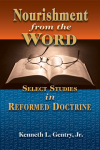
Nourishment from the Word (by Ken Gentry)
Reformed studies covering baptism, creation, creeds, tongues, God’s law, apologetics, and Revelation
See more study materials at: www.KennethGentry.com
IN THE NEW TESTAMENT. As might be expected, the New Testament has more to say on the resurrection of the dead than the Old, because it brings the climax of God’s revelation on this point in the resurrection of Jesus Christ. Over against the denial of the Sadducees, Jesus argues the resurrection of the dead from the Old Testament, Matt. 22:23-33, and parallels, cf. Ex. 3:6. Moreover, He teaches that great truth very clearly in John 5:25-29; 6:39,40,44,54; 11:24,25; 14:3; 17:24. The classical passage of the New Testament for the doctrine of the resurrection is I Cor. 15. Other important passages are: I Thess. 4:13-16; II Cor. 5:1-10; Rev. 20:4-6 (of dubious interpretation), and 20:13.C. THE NATURE OF THE RESURRECTION.IT IS A WORK OF THE TRIUNE GOD. The resurrection is a work of the triune God. In some cases we are simply told that God raises the dead, no person being specified, Matt. 22:29; II Cor. 1:9. More particularly, however, the work of the resurrection is ascribed to the Son, John 5:21,25,28,29; 6:38-40, 44,54; I Thess. 4:16. Indirectly, it is also designated as a work of the Holy Spirit, Rom. 8:11.IT IS A PHYSICAL OR BODILY RESURRECTION. There were some in the days of Paul who regarded the resurrection as spiritual, II Tim. 2:18. And there are many in the present day who believe only in a spiritual resurrection. But the Bible is very explicit in teaching the resurrection of the body. Christ is called the “firstfruits” of the resurrection, I Cor. 15:20,23, and “the firstborn of the dead,” Col. 1:18; Rev. 1:5. This implies that the resurrection of the people of God will be like that of their heavenly Lord. His resurrection was a bodily resurrection, and theirs will be of the same kind.
Moreover, the redemption wrought by Christ is also said to include the body, Rom. 8:23; I Cor. 6:13-20. In Rom. 8:11 we are told explicitly that God through His Spirit will raise up our mortal bodies. And it is clearly the body that is prominently before the mind of the apostle in I Cor. 15, cf. especially the verses 35-49. According to Scripture there will be a resurrection of the body, that is, not an entirely new creation, but a body that will be in a fundamental sense identical with the present body. God will not create a new body for every man, but will raise up the very body that was deposited in the earth. This cannot only be inferred from the term “resurrection,” but is clearly stated in Rom. 8:11, I Cor. 15:53, and is further implied in the figure of the seed sown in the earth, which the apostle employs in I Cor. 15:36-38. Moreover, Christ, the firstfruits of the resurrection, conclusively proved the identity of His body to His disciples.
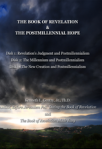
The Book of Revelation and Postmillennialism (Lectures by Ken Gentry)
In the first of these three 50-minute lectures Gentry explains Revelation’s judgments to show they do not contradict postmillennialism. In the next two lectures he shows how the Millennium and the New Creation themes strongly support the gospel victory hope found in postmillennialism.
See more study materials at: www.KennethGentry.com
At the same time Scripture makes it perfectly evident that the body will be greatly changed. Christ’s body was not yet fully glorified during the period of transition between the resurrection and the ascension; yet it had already undergone a remarkable change. Paul refers to the change that will take place, when he says that in sowing a seed we do not sow the body that shall be; we do not intend to pick the same seed out of the ground. Yet we do expect to reap something that is in a fundamental sense identical with the seed deposited in the earth. While there is a certain identity between the seed sown and the seeds that develop out of it, yet there is also a remarkable difference. We shall be changed, says the apostle, “for this corruptible must put on incorruption, and this mortal must put on immortality.” The body “is sown in corruption; it is raised in incorruption: it is sown in dishonor; it is raised in power; it is sown a natural body; it is raised a spiritual body.” Change is not inconsistent with the retention of identity. We are told that even now every particle in our bodies changes every seven years, but through it all the body retains its identity. There will be a certain physical connection between the old body and the new, but the nature of this connection is not revealed.
Some theologians speak of a remaining germ from which the new body develops; others say that the organizing principle of the body remains. Origen had something of that kind in mind; so did Kuyper and Milligan. If we bear all this in mind, the old objection against the doctrine of the resurrection, namely, that it is impossible that a body could be raised up, consisting of the same particles that constituted it at death, since these particles pass into other forms of existence and perhaps into hundreds of other bodies, loses its force completely.
IT IS A RESURRECTION OF BOTH THE RIGHTEOUS AND THE WICKED. According to Josephus the Pharisees denied the resurrection of the wicked.[Ant. XVIII. 1,3; Wars II. 8.14.] The doctrine of annihilationism and that of conditional immortality, both of which, at least in some of their forms, deny the resurrection of the ungodly and teach their annihilation, embraced by many theologians, has also found favor in such sects as Adventism and Millennial Dawnism. They believe in the total extinction of the wicked. The assertion is sometimes made that Scripture does not teach the resurrection of the wicked, but this is clearly erroneous, Dan. 12:2; John 5:28,29; Acts 24:15; Rev. 20:13-15. At the same time it must be admitted that their resurrection does not stand out prominently in Scripture. The soteriological aspect of the resurrection is clearly in the foreground, and this pertains to the righteous only. They, in distinction from the wicked, are the ones that profit by the resurrection.IT IS A RESURRECTION OF UNEQUAL IMPORT FOR THE JUST AND THE UNJUST. Breckenridge quotes I Cor. 15:22 to prove that the resurrection of both saints and sinners was purchased by Christ. But it can hardly be denied that the second “all” in that passage is general only in the sense of “all who are in Christ.” The resurrection is represented there as resulting from a vital union with Christ. But, surely, only believers stand in such a living relation to Him. The resurrection of the wicked cannot be regarded as a blessing merited by the mediatorial work of Christ, though it is connected with this indirectly. It is a necessary result of postponing the execution of the sentence of death on man, which made the work of redemption possible. The postponement resulted in the comparative separation of temporal and eternal death, and in the existence of an intermediate state. Under these circumstances it becomes necessary to raise the wicked from the dead, in order that death in its widest extent and in all its weight might be imposed on them. Their resurrection is not an act of redemption, but of sovereign justice, on the part of God. The resurrection of the just and the unjust have this in common, that in both bodies and souls are reunited. But in the case of the former this results in perfect life, while in the case of the latter it issues in the extreme penalty of death, John 5:28,29.D. THE TIME OF THE RESURRECTION.
THE PREMILLENNIAL VIEW RESPECTING THE TIME OF THE RESURRECTION. It is the common opinion among Premillenarians that the resurrection of the saints will be separated by a thousand years from that of the wicked. They almost seem to regard it as an axiomatic truth that these two classes cannot possibly arise at the same time. And not only that, but the type of Premillennialism which is now dominant, with its theory of a twofold second coming of Christ, feels the need of positing a third resurrection. All the saints of former dispensations and of the present dispensation are raised up at the parousia or the coming of the Lord. Those still alive at that time are changed in a moment, in the twinkling of an eye. But in the seven years that follow the parousia many other saints die, especially in the great tribulation. These must also be raised up, and their resurrection will occur at the revelation of the day of the Lord. seven years after the parousia. But even at this point Premillenarians cannot very well stop. Since the resurrection at the end of the world is reserved for the wicked, there must be another resurrection of the saints who die during the millennium, which precedes that of the wicked, for the two cannot be raised up at the same time.SCRIPTURAL INDICATIONS AS TO THE TIME OF THE RESURRECTION. According to Scripture the resurrection of the dead coincides with the parousia, with the revelation or the day of the Lord, and with the end of the world, and will immediately precede the general and final judgment. It certainly does not favor the premillennial distinctions with respect to this doctrine.In several places it represents the resurrection of the righteous and that of the wicked as contemporaneous, Dan. 12:2; John 5:28,29; Acts 24:15; Rev. 20:13-15. All of these passages speak of the resurrection as a single event and do not contain the slightest indication that the resurrection of the righteous and that of the wicked will be separated by a period of a thousand years. But this is not all that can be said in favor of the idea that the two coincide.
In John 5:21-29 Jesus combines the thought of the resurrection, including the resurrection of the righteous, with the thought of the judgment, including the judgment of the wicked. Moreover, II Thess. 1:7-10 clearly represents the parousia (vs. 10), the revelation (vs. 7), and the judgment of the wicked (vs. 8,9) as coinciding. If that is not the case, language would seem to have lost its meaning.
Furthermore, the resurrection of believers is directly connected with the second coming of the Lord in I Cor. 15:23; Phil. 3:20,21; and I Thess. 4:16, but it is also represented as occurring at the end of the world, John 6:39,40,44,54 or at the last day. That means that believers are raised up at the last day, and that the last day is also the day of the coming of the Lord. Their resurrection does not precede the end by a period of a thousand years. Happily, there are several Premillenarians who do not accept the theory of a threefold resurrection, but who nevertheless cling to the doctrine of a double resurrection.

Blessed Is He Who Reads: A Primer on the Book of Revelation By Larry E. Ball
A basic survey of Revelation from an orthodox, evangelical, and Reformed preterist perspective. Ball understands John to be focusing on the destruction of Jerusalem and the temple in AD 70. Insightful. Easy to read.
For more Christian studies see: www.KennethGentry.com
April 25, 2023
SANDLIN ON DEMAR’S HIDDEN VIEWS
PMW 2023-033 by Andrew Sandlin
The following article written by Andrew Sandling, President of Center for Cultural Leadership explains why he (and I and many others!) did not notice Gary DeMar’s commitment to the core principles of hyperpreterism until recently.

Gary DeMar’s Heretical Eschatology: What Did I Know, and When Did I Know It?
By P. Andrew Sandlin
I don’t intend to pursue further the controversy over Hyper-Pretersim (HP) brought to light by this letter signed by a number of Gary’s friends.
But I feel obliged to respond to Gary’s statement that he hasn’t changed his views in about 25 years, and that I have continued to promote him during that time, and only lately have I objected to his views. Have I just over the last few months become more severe in my judgment on heresy? Was I tolerant of Gary’s false teaching for a quarter century and only in the last few weeks become publicly intolerant of it?
The short answer is no. Here’s the longer answer:
Gary is quite correct that I had concerns over his eschatology 25 years ago. The (HP) heresy was rearing its ugly head. Its books were being carried by the late Walt Hibbard at the now defunct Great Christian Books, which was influential in the Reformed camp at that time. By reliable accounts, noted author David Chilton had embraced the HP heresy before his premature death. Many people seemed to have had the impression that to embrace postmillennialism was to embrace preterism, and even heretical HP.
At the time I was at the Chalcedon Foundation, a postmillennial (but non-preterist) ministry, and I publicly opposed the HP heresy. I published an article by Ken Gentry opposing it. Since I knew Gary as a preterist was speaking very publicly about eschatology, I asked him if he embraced HP. His response was annoyance, and, as I recall, even indignation. I made an assumption at the time, and it now appears it was an incorrect assumption: that Gary was indignant that I would dare to ask him if he held to orthodox Christianity, since he obviously did. I now see he was indignant that I would question him about his beliefs at all, and that already, at that time, he was moving to the edges or outside the Christian Faith.
In the intervening years, I have read almost nothing of Gary’s eschatology. I assumed that he was a partial preterist like Ken Gentry. Ken has always been solidly orthodox, and I assumed that Gary basically agreed with Ken. Anything I’ve read of Gary’s the last 25 years has dealt with his cultural critiques, which have been excellent. When I asked him to write the chapter on eschatology for our recent book Failed Church, I certainly did not believe he stood outside the orthodox Faith, and that chapter does not express any heresy. It appears now, as a result of Gary’s recent, or at least recently publicized, statements, CCL will need to exclude that chapter from the book. I certainly would never have recruited Gary to write had I known his actual views.
The late Ken Talbot, founder and president of Whitefield Seminary, called me four or five years ago to warn me that he thought Gary was moving into the HP heresy. He said that Gary was speaking at HP conferences, and while there would never offer any kind of distinction between his view and theirs. Because I try to avoid guilt-by-association, I didn’t assume this meant Gary himself was HP. I believe Ken told me that he either left or was voted off the American Vision board because he took a stand on this issue. I don’t know the details about this, but I’m certain that’s what he told me. Ken was a strong opponent of the HP heresy.
Only in the last year have I become increasingly aware of Gary’s eschatological heresy. I was first alerted to it when early last year I listened to a podcast of his in which he answered a listener’s question of which NT texts teach the Second Coming. His response was that those who believe in the Second Coming refer to several biblical texts. He did not state that he believes the Bible teaches the Second Coming.
And then I noted that Gary refused on Facebook to answer Ken Gentry’s basic questions about whether Gary believed in the future bodily Second Coming, and the future bodily resurrection and judgment of the righteous and unrighteous, all of which all orthodox Christians affirm. Gary had consistently prodded Ken with public questions that, at best, indicated a tolerance for HP. Ken assembled a group of Gary’s friends to write him privately about this. Gary did not respond. We sent this letter twice, and I engaged with Gary privately about it, though Gary abruptly ended that exchange. Some have suggested that we should have contacted Gary privately before publishing that letter. We did. Several times.
It was that collaborative private letter that, with cosmetic revision, we published recently. No fair-minded person could claim this letter is bitter, mean, bullying, or unloving.
Over the last two weeks, several friends have provided me with evidence that, unknown to me, over the last two or three years Gary has been bold to deny fundamental elements of the Christian Faith. Here’s a clip filmmaker Nathan Anderson provided me from an interview within the last couple of years in which Gary denies the future physical resurrection. This episode was especially troubling since it seems Gary was being interviewed on a non-Christian program. And then Matt Doyle wrote this on his Facebook page:
“The fact is Gary has exegeted 1 Cor. 15. He just doesn’t want us to know that since it conflicts with his present HP views.
I found a PDF of Gary DeMar’s 1999 edition of Last Day Madness which was a revision of the original 1994 edition.
‘Jesus coming in 70 AD was a coming in judgment upon an apostate nation. When Jesus returns bodily — a still future event — He will have “abolished all rule and authority and power,’ having put ‘all His enemies under His feet. The last enemy that will be abolished is death’ (1 Corinthians 15:24-26). We await this glorious coming.” Last Day Madness (1994) — Gary DeMar, p. 318
In comparing it to the fourth edition (1999) what did I find? It had been edited out. So as long as 24 years ago Gary was headed down the HP path. When in recent times I asked him to affirm that he still held this view he refused to answer.
As further proof I call your attention to this:
In a recent article (“The End of the Age” (Part 1) https://bit.ly/3DmhmPS he said this:
“‘The end’ in Matthew 10:22; 13:39, 40, 49; 28:20; Mark 13:7, 13; Luke 21:9; 1 Corinthians 1:8; 10:11; 15:24; Hebrews 3:6, 14; 6:11; 9:26; Revelation 2:26 means nothing more than the end being described in the context, not the end of everything.”
Notice that he quotes 1 Cor. 15:24 as being in this category. This is a complete contradiction of what he said in Last Day Madness in 1994. Is there any wonder that when he is asked to give passages for where the yet future, bodily, Second Coming of Christ appears in Scripture he does not cite 1 Cor. 15:24-25 (or any other passages) as he did in Last Day Madness? He no longer holds that it is about “the end” of all things but only the “end of the age” in 70 AD. If that is not Full Preterism, then I guess I don’t know what is.
Also, do you think Gary would affirm this today?
“…believers will not enter the kingdom with disembodied souls. They will enter the final kingdom with resurrected, spiritual bodies (emphasis his). Jesus ate with His disciples after His resurrection (Luke 24:40-43). His disciples were able to touch and see Him. He even called attention to His ‘flesh and bones’ (Luke 24:39). Yet, he was raised with a spiritual body (1 Cor. 15:45-46).” The Reduction of Christianity, (1988), p.154
I cannot verify all of Matt’s original sources, but you might understand how these revelations troubled me.
Gary has begged for patience while he works through these eschatological issues. For awhile, I referred to his views as “agnostic” and “ambiguous.” It is clear to me now that his views are no longer agnostic or ambiguous at all. He simply denies the orthodox Faith. Indeed, he mocks it, as he does here from a public statement over the last few days:

These are not the assertions of a man on a theological journey, but a man who has arrived at a comfortable residence safely ensconced outside orthodox Christianity.
I am now willing to acknowledge Gary has held his present heretical views for 25 years. My honest explanation for why I’ve continued to promote him during that long time is that I did not know he held these views. Perhaps I’ve been naïve in not investigating further, but when these views did become apparent to me, I did confront Gary.
My opposition to heresy and false doctrine is not severer now than it was 25 years ago. I abominate the heresy when the theological liberals mock the future bodily resurrection, and I abominate it when Gary mocks it. Both are destructive heresies.
I did not know until very recently that Gary has now embraced full-bore heresy. I know it now.
And I oppose (and have always opposed) these views — without apology, and without qualification.
Addendum by Ken Gentry
Gary used to clearly and forcefully declare orthodox eschatology. Now he attempts to side-step the issues by refusing to answer directly. Consider his earlier views. See if he will affirm them or affirm American Vision’s Statement of Faith. Note the following quotes from Gary:
“Jesus coming in 70 AD was a coming in judgment upon and apostate nation. When Jesus returns bodily–a still future event–He will have “abolished all rule and authority and power,” having put “all His enemies under His feet. The last enemy that will be abolished is death” (1 Corinthians 15:24-26). We await this glorious coming.”
Last Day Madness (1994), p.318
“The chapter (1 Cor. 15) deals with the resurrection not the Rapture: first, the resurrection of Jesus; second the resurrection of Christians. Without the resurrection of Jesus there will be no resurrection of Christians. The resurrection of believers comes just before the end: “But each in his own order: Christ the first fruits, after that those who are Christ’s at His coming, then comes the end, when he delivers up the kingdom to God the Father, when he has abolished all rule and all authority and power (15:23-24). The “resurrection of the dead” occurs after the period of the kingdom (there must be something to deliver up) and just before “the end.”
Ibid, p. 192
”As has been demonstrated in the previous chapters, the events rehearsed in the Olivet Discourse (Matthew 24, Mark 13, Luke 21) are signs leading up to and including the destruction of Jerusalem in 70 AD. These chapters have nothing to do with when Jesus will return at the final judgment. There are no observable signs leading up to His bodily return!
”So then, when will Jesus return? The only “sign” the Bible gives us is the fullness of the kingdom, “when He has abolished all rule and authority and power. For He must reign until He has put all His enemies under his feet” (1 Corinthians 15:24-25). We know that Jesus is presently reigning over the Universe from heaven. Heaven is His throne and earth His footstool (Isaiah 66:1). He will continue to reign in this manner until all his enemies are put under his feet (Psalm 110:1; Acts 2:35). When this is accomplished, Jesus will return to judge the living and the dead. It will be at the time when “the dead in Christ shall rise first. Then we who are alive and remain shall be caught up together with them in the clouds to meet the Lord in the air, and thus we shall always be with the Lord (1 Thessalonians 4:16-17).”
Ibid, p. 151
For more excellent articles by Sandlin and his associates, see the Center for Cultural Leaderhip website.
Kenneth L. Gentry Jr.'s Blog
- Kenneth L. Gentry Jr.'s profile
- 85 followers



